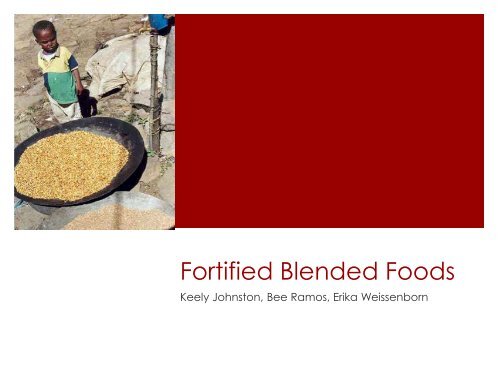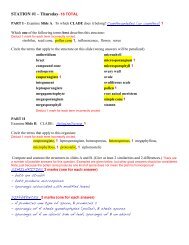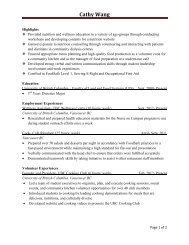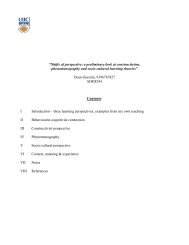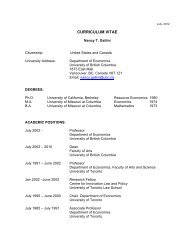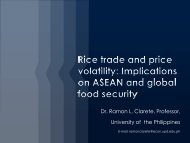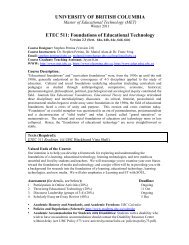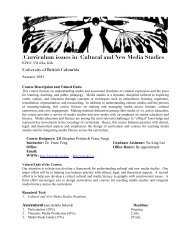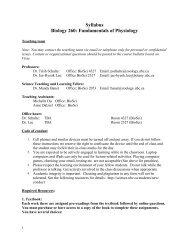Fortified Blended Foods PowerPoint - UBC Blogs
Fortified Blended Foods PowerPoint - UBC Blogs
Fortified Blended Foods PowerPoint - UBC Blogs
You also want an ePaper? Increase the reach of your titles
YUMPU automatically turns print PDFs into web optimized ePapers that Google loves.
<strong>Fortified</strong> <strong>Blended</strong> <strong>Foods</strong><br />
Keely Johnston, Bee Ramos, Erika Weissenborn
Agenda<br />
• Introduction<br />
• FBF Background<br />
• Cultural Significance<br />
• GAME<br />
• Political, Social & Economic Issues<br />
• Conclusion<br />
• Questions
World Food Program - FBF<br />
• FBFs contain adequate calories (400kcal/100g) and<br />
protein (15g/100g)<br />
• <strong>Fortified</strong> with essential micronutrients<br />
• Usually missing from the diet<br />
• Pre-cooked and distributed as flour<br />
• Easy to prepare, low fuel requirements<br />
• Easy to digest for young children<br />
• Relatively inexpensive<br />
• More sustainable<br />
• Versatile food – can be prepared in a number of ways
FBF Worldwide Distribution<br />
Asia (20%)<br />
Africa (>50%)<br />
Latin America and the<br />
Caribbean : 15%<br />
(Rowe et al., 2008)
FBF Background
Wheat Soy Blend (WSB)<br />
Bulgar Flour<br />
Wheat Protein<br />
Concentrate<br />
Soy Flour<br />
Soybean oil<br />
Vitamin and<br />
Mineral Premix
Corn Soy Blend (CSB)<br />
Corn Meal<br />
Soy Flour<br />
Soybean Oil<br />
Mineral and<br />
Vitamin Premix
Soy <strong>Fortified</strong> Bulgur<br />
Bulgar<br />
Soy grits
Vitamin/Mineral Premix<br />
Vitamin/Mineral Target Chemical Form<br />
Vitamin A 1664 IU Dry vitamin A palmitate<br />
Thiamine 0.128 mg Thiamine mononitrate<br />
Riboflavin 0.448 mg Riboflavin<br />
Niacin 4.8 mg Nicotinamide<br />
Pantothenic acid 6.7 mg Calcium d-pantothenate<br />
Vitamin B6 1.7 mg Pyridoxine hydochloride<br />
Folate 60 mcg Folic acid<br />
Vitamin B12 2 mcg Vitamin B12<br />
Vitamin C 100 mg Ascorbic acid<br />
Vitamin D 4 mcg Dry vitamin D3 100 CWS<br />
Vitamin E 8.3 mg Vitamin E 50% CWS<br />
Vitamin K 100 mcg Vitamin K1 5% CWS<br />
Iron (a) 4 mg Ferrous fumarate<br />
Iron (b) 2.5 mg Iron-sodium EDTA<br />
Zinc 5 mg Zinc oxide<br />
Iodine 40 mcg Potassium iodate<br />
Potassium 400 mg Potassium chloride<br />
Phosphorus 200 mg Monocalcium phosphate<br />
Calcium<br />
130 mg
Vitamin/Mineral Premix<br />
Vitamin/Mineral Target Chemical Form<br />
Vitamin A 1664 IU Dry vitamin A palmitate<br />
Thiamine 0.128 mg Thiamine mononitrate<br />
Riboflavin 0.448 mg Riboflavin<br />
Niacin 4.8 mg Nicotinamide<br />
Pantothenic acid 6.7 mg Calcium d-pantothenate<br />
Vitamin B6 1.7 mg Pyridoxine hydochloride<br />
Folate 60 mcg Folic acid<br />
Vitamin B12 2 mcg Vitamin B12<br />
Vitamin C 100 mg Ascorbic acid<br />
Vitamin D 4 mcg Dry vitamin D3 100 CWS<br />
Vitamin E 8.3 mg Vitamin E 50% CWS<br />
Vitamin K 100 mcg Vitamin K1 5% CWS<br />
Iron (a) 4 mg Ferrous fumarate<br />
Iron (b) 2.5 mg Iron-sodium EDTA<br />
Zinc 5 mg Zinc oxide<br />
Iodine 40 mcg Potassium iodate<br />
Potassium 400 mg Potassium chloride<br />
Phosphorus 200 mg Monocalcium phosphate<br />
Calcium<br />
130 mg
Vitamin/Mineral Premix<br />
Vitamin/Mineral Target Chemical Form<br />
Vitamin A 1664 IU Dry vitamin A palmitate<br />
Thiamine 0.128 mg Thiamine mononitrate<br />
Riboflavin 0.448 mg Riboflavin<br />
Niacin 4.8 mg Nicotinamide<br />
Pantothenic acid 6.7 mg Calcium d-pantothenate<br />
Vitamin B6 1.7 mg Pyridoxine hydochloride<br />
Folate 60 mcg Folic acid<br />
Vitamin B12 2 mcg Vitamin B12<br />
Vitamin C 100 mg Ascorbic acid<br />
Vitamin D 4 mcg Dry vitamin D3 100 CWS<br />
Vitamin E 8.3 mg Vitamin E 50% CWS<br />
Vitamin K 100 mcg Vitamin K1 5% CWS<br />
Iron (a) 4 mg Ferrous fumarate<br />
Iron (b) 2.5 mg Iron-sodium EDTA<br />
Zinc 5 mg Zinc oxide<br />
Iodine 40 mcg Potassium iodate<br />
Potassium 400 mg Potassium chloride<br />
Phosphorus 200 mg Monocalcium phosphate<br />
Calcium<br />
130 mg
FBF Standards<br />
• Federal Food, Drug, and Cosmetic Act<br />
(USAID)<br />
• Codex Alimentarius (WFP)
FBF Safety<br />
HACCP<br />
• Hazard Analysis and Critical Control<br />
Points<br />
GMP<br />
• Good Manufacturing Practices
Processing<br />
• Methods of processing:<br />
• Extrusion (wet or dry)<br />
• Roasting
Effects of Processing on FBF<br />
• Improved digestibility of starches and<br />
proteins<br />
• Inactivates anti-nutritional factors<br />
• Maillard Browning
Final Product Specifications<br />
• Urease Test<br />
• Nutrient values<br />
• Flour size<br />
• Microbiology<br />
• Aflatoxins<br />
• Peroxide value<br />
• Dispersiveness<br />
• Bostwick test
Packaging and Storage<br />
• 25 kg bags<br />
• Polypropylene<br />
• Rip-proof<br />
• Moisture barrier<br />
• Sealing<br />
• Shelf life<br />
• Minimum one year when stored at ambient<br />
temperatures prevalent in country of destination
Culturally Appropriate FBF<br />
To ensure FBF meet the cultural and nutritional<br />
needs of a community an organization must:<br />
- Identify traditional recipes and ingredients<br />
- <strong>Fortified</strong> blended food recipes (WFP)*<br />
- Understand food preparation customs<br />
- Are they consumed immediately after prepared?<br />
- Cooking time and temperature<br />
- Do traditional cooking methods reduce micronutrient<br />
content of food?<br />
- Typical times for meals and number of meals per day<br />
(Rowe, et al., 2008)
Culturally Appropriate FBF<br />
- Define how the product will reach target populations<br />
- Wet feeding sites?<br />
- Local programs, distribution centers, door-to- door delivery<br />
- Average household size?<br />
- Ration size- per household or per person<br />
- Evaluate resources available in a community<br />
- Is fuel for cooking available?<br />
- Where does food preparation take place?<br />
- Cooking equipment: cast iron or clay pots?<br />
- Water – is clean water available or boiled before use?<br />
- Objective measurements to determine water quality<br />
- pH, microbial counts, turbidity<br />
(Rowe, et al., 2008)
Case Study: Guatemala<br />
• <strong>Foods</strong> Consumed in Guatemala that can be prepared with FBF<br />
Cookies<br />
Galletas<br />
Vegetable Stew<br />
Guiso<br />
Food Drink<br />
Atole<br />
Tortillas<br />
• FBF distributed in Guatemala: Soy fortified bulgur not corn soy blend (CSB)<br />
• FBF - mixed with oil (fortified), sugar, water, vegetables<br />
(Rowe, et al., 2008)
Case Study: Guatemala cont’d<br />
• Product distributed to<br />
• Households participating in maternal and<br />
child health programs in Central Guatemala,<br />
province of Baja Verapaz, Quiche province<br />
• Guatemalan private voluntary organizations<br />
distributed vegetable oil fortified with<br />
Vitamin A<br />
• Recipients transferred oil into plastic bottles<br />
at distribution sites<br />
(Rowe, et al., 2008)
Case Study: Guatemala cont’d<br />
• Food preparation<br />
• 98% of Guatemalan beneficiaries followed WFP<br />
recipes<br />
• Often included herbs, bananas and cinnamon in<br />
meals<br />
• Location: covered areas away from sunlight<br />
• Tortillas and cookies: baked for 15-20 minutes<br />
• Vegetable stew and thin porridge: boiled
Case Study: Malawi<br />
Thin Porridge<br />
Phala<br />
Food Cake<br />
Chikondamoyo<br />
Banana Leaf Rolls<br />
Mkate<br />
Thick Porridge<br />
Nisma<br />
(Rowe, et al., 2008)
Case Study: Malawi cont’d<br />
• Product distributed to<br />
• Households participating in food for<br />
work, chronically ill and orphan<br />
household programs in Dedza District,<br />
Mchinji District and Thyolo District<br />
• At least 75% of daily diet in Malawi<br />
derived from food aid<br />
• Vegetable oil fortified with vitamin A<br />
used as an ingredient to prepare FBF<br />
(Rowe, et al., 2008)
Resources<br />
• Wood fueled fire<br />
• Aluminum or clay pots<br />
• Water<br />
• Boreholes or open wells<br />
• pH range: 4.7 to 7.7<br />
• Water boiled<br />
(Rowe, et al., 2008)
Haiti<br />
• Haiti: Quake Kids Get Nutritious Breakfast<br />
• http://www.wfp.org/countries/Haiti/Media/Haiti--<br />
Starting-Over-From-School
GAME: HELP DELIVER FBFs AROUND THE<br />
WORLD!
Political, Social & Economic<br />
Issues
Target Population<br />
• Children suffering moderate malnutrition<br />
• Due to constraints including poverty, political instability and food<br />
insecurity.<br />
• Vulnerable Groups<br />
• Pregnant and lactating women<br />
• Chronically ill-HIV/AIDS and TB<br />
• People affected by disaster-related emergencies<br />
• Refugees, natural disaster<br />
• Populations requiring food assistance<br />
• Drought, lean/bad harvest periods<br />
• Populations who consume monotonous diets<br />
• Root vegetables<br />
(De Pee & Bloem, 2009)
Malnutrition<br />
Stunted Growth<br />
•Low Height for Age<br />
•Signs of Chronic<br />
Malnutrition<br />
•Irreversible<br />
•Linked to premature<br />
death<br />
Wasting<br />
•Low Weight for<br />
Height<br />
•Acute Malnutrition<br />
•Starvation/Disease<br />
•Can be reversed
The Intergenerational Cycle of<br />
Malnutrition<br />
World Food Program<br />
Malnourished<br />
Women<br />
Stunted<br />
Adolescents<br />
Low Birth<br />
Weight Babies<br />
Stunted<br />
Children
Question:<br />
How does the intergenerational cycle of<br />
Malnutrition affect a Country's economy?
Breaking the cycle of<br />
malnutrition<br />
One of WFP's main<br />
goals with <strong>Fortified</strong><br />
<strong>Blended</strong> <strong>Foods</strong> is to try<br />
to diminish the<br />
devastating cycle of<br />
intergeneration<br />
malnutrition
Distributors<br />
• Main Distributor: World Food Program<br />
• Secondary Distributors: Various NGOs<br />
• World Food Program receives the bulk of the<br />
<strong>Fortified</strong> <strong>Blended</strong> Food products from the US.<br />
How is this affecting the beneficiary's economy?
<strong>Fortified</strong> <strong>Blended</strong> <strong>Foods</strong> and Genetically<br />
Modified Organisms: Case Study<br />
Can beggars be choosers?<br />
• South African 2002 food crisis<br />
• 26% of the population had critical food shortages<br />
• USA responded with food aid<br />
• Malawi, Mozambique, Zambia, Zimbabwe rejected<br />
US food aid because it contained GMOs<br />
• Concern of health consequences, agricultural<br />
biodiversity, future exports<br />
• USA says “a crime against humanity!” “Beggars can't<br />
be choosers!”
Local Economies and WFP<br />
• WFP does receive the bulk of funding and<br />
supplies through the US (excess?)<br />
• The WFP is making initiatives to produce <strong>Fortified</strong><br />
<strong>Blended</strong> <strong>Foods</strong> locally<br />
• Helping local economies<br />
2 examples: Kenya and Liberia
Local Production of FBFs<br />
A success story: Kenya
Economic Hardships and<br />
FBF<br />
• Barrier between iron/zinc requirements of<br />
infants/children and what FBFs can provide<br />
• This gap can easily be filled by<br />
• consuming animal sourced foods<br />
• further fortification<br />
Do you have any ideas of how to overcome<br />
the barrier between FBFs and children's need<br />
for iron and zinc?
Product improvement needed<br />
• FBF do not meet the nutritional needs of moderately<br />
malnourished children<br />
• Inadequate micronutrient content<br />
• Insufficient iron, no vitamin C<br />
• Low content of essential fatty acids and fats<br />
• High anti-nutrients and fiber content<br />
• Non-dehulled soy,<br />
• Non-degermed maize and wheat: higher fiber content<br />
• Insufficient energy per serving<br />
• High bulk and viscosity<br />
• Does not provide a source of animal protein<br />
• Powdered Milk<br />
(De Pee & Bloem, 2009)
Improvements and<br />
recommendations<br />
• Improve nutritional content and absorption<br />
• Changing the micronutrient premix<br />
• Increase content and bioavailability of nutrients<br />
• Adding milk powder<br />
• Increasing oil content<br />
• De-germing maize and de-hulling soy<br />
• Reducing phytate content with the addition of phytase enzyme<br />
• Phytase not GRAS<br />
• Improve Product Quality<br />
• Include specifications for maximum content of heavy metals.<br />
• Reduce content of toxins and contaminants<br />
• lower maximum level for aflatoxins (5 instead of 20ppb)<br />
• Enforce tighter specifications for microbiological content<br />
• (De Pee & Bloem, 2009)
Questions?
References<br />
FBF Background<br />
• Peres-Exposito, A. B., Klein, B.P. (2009) Impact of fortified blended food aid products on nutritional status of<br />
infants and young children in developing countries. Nutr. Reviews., 67(12), 706-718.<br />
• World Food Programme. (2002). <strong>Fortified</strong> <strong>Blended</strong> <strong>Foods</strong>: Recipes, Facts and Practical Uses. Pp. 58.<br />
• World Food Programme. (2010). Technical Specifications for the manufacture of Wheat Soya Blend For Young<br />
Children and Adults. Pp 8.<br />
• USDA. (1996) Fact Sheet: Corn Soy Blend.<br />
http://www.fas.usda.gov/excredits/pl480/commodities/cornsoy.html [Accessed February 2, 2011]<br />
• USDA. (1997) Fact Sheet: Fact Sheet: Wheat Soy Blend. http://www.fas.usda.gov/excredits/wheatsoy.html<br />
[Accessed February 2, 2011]<br />
Culturally Adequate<br />
• de Pee S, Bloem MW. Current and potential role of specially formulated foods and food supplements for<br />
preventing malnutrition among 6- to 23-month-old children and for treating moderate malnutrition among 6-<br />
to 59-month-old children. Food Nutr Bull. 2009 Sep;30(3 Suppl):S434-63. PubMed PMID: 19998866.<br />
De Pee & Bloem, 2009)<br />
• Rowe, J. P., Brodegard, W. C., Pike, O. A., Steele, F. M., & Dunn, M. L. (2008). Storage, preparation, and usage<br />
of fortified food aid in the diet of Guatemalan, Ugandan, and Malawian beneficiaries: A field study report.<br />
Food Nutr. Bull., 29(3), 213–220.<br />
Political, Social, and Economical Issues<br />
• Zerbe, Noah (2004.) Feeding the Famine? American Food Aid and the GMO debate in Southern Africa. Food<br />
Policy, 29, 593-608.<br />
• Hertz, Goete (1997.) Production of pre-cooked fortified foods in Kenya: A success story. Issue 2, Page 6.


